Yellowstone sits in the Northwest corner of Wyoming and is famous for being the first national park in the world. The park opened to the public in 1872 and is 3,471 square miles large. Freshwater sources are abundant in Yellowstone, and more than 600 lakes and ponds in the park and rivers run through the area. One of the most common animals in the water is fish. Here you will learn about 12 fish that live in Yellowstone National Park.
Yellowstone has a variety of fish, and while new species may be introduced to the area, it is also possible for a current fish species to become extirpated. Fish are an important part of the ecosystem in Yellowstone, and they are one of the many forms of wildlife that live in the area. Let’s take a look at 12 fish that swim in the waters of Yellowstone National Park.
1. Arctic Grayling
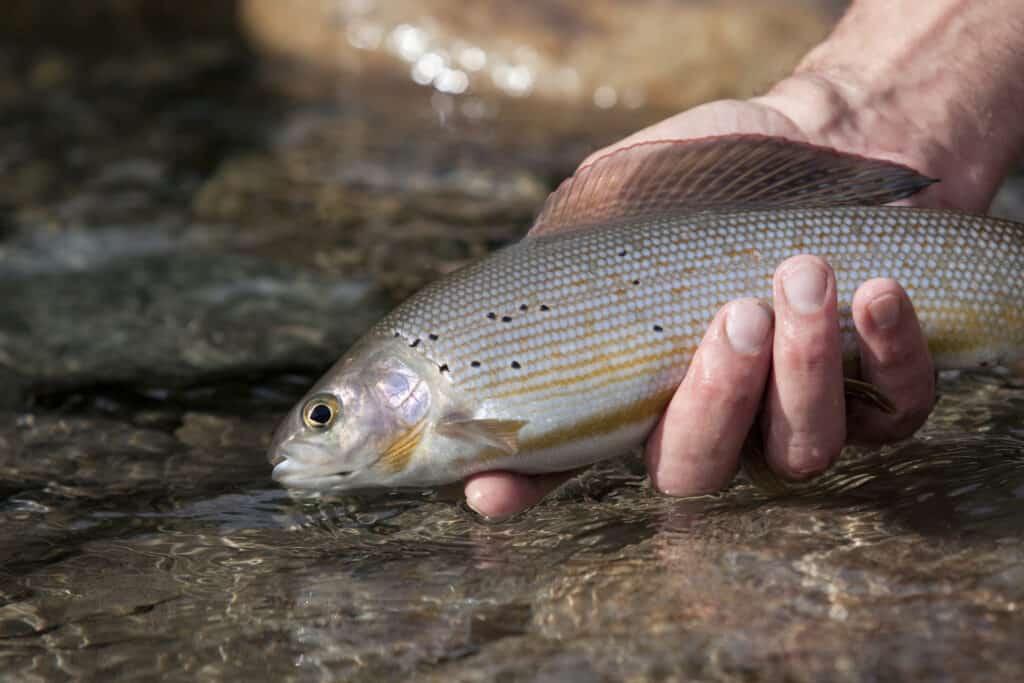
With a size of around 8 to 24 inches, the arctic graylings’ weight ranges between 5 to 8 lbs.
©iStock.com/Alaska_icons
Arctic graylings (Thymallus arcticus) are a species that was once found all over Yellowstone, but now they are limited to just a few water sources in the parks. Grebe Lake is one of the few areas you can find this fish.
The population of this fish reduced due to other fish like brown trout being introduced to the area and limiting their resources.
With a size of around 8 to 24 inches, the arctic graylings’ weight ranges between 5 to 8 lbs. They have a gray coloring and a large dorsal fin, and this fish has an iridescent shine and a speckled pattern on them. Other similar fish easily out-compete this species, so they are not as common.
2. Mountain Whitefish
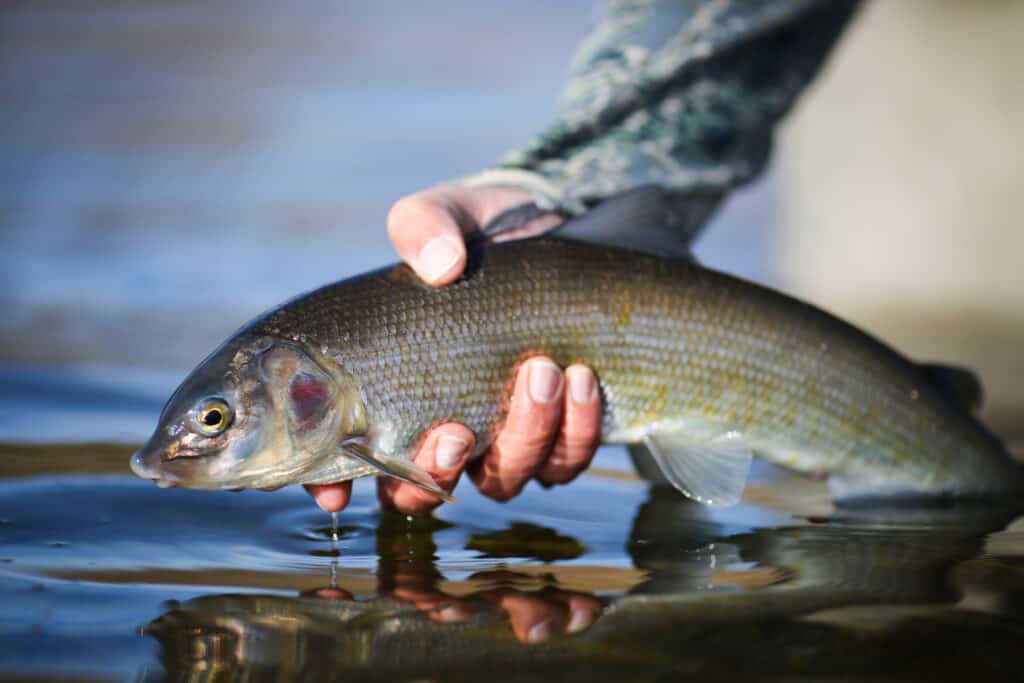
The mountain whitefish prefers to live in streams with deep clear water as they cannot tolerate polluted water.
©Cannon Colegrove/Shutterstock.com
Often confused for the arctic grayling, the mountain whitefish (Prosopium williamsoni) is a species inhabiting Yellowstone’s waters. This species is considered one of the best fish to eat because of its taste and high-fat content. Around 10 to 16 inches long, this species has gray coloring and weighs around 5 lbs when mature.
This species of fish prefers to live in streams with deep clear water as they cannot tolerate polluted water. While hanging around near the bottom of the water, they feed on animals like snails, crayfish, and other bottom animals.
3. Speckled Dace
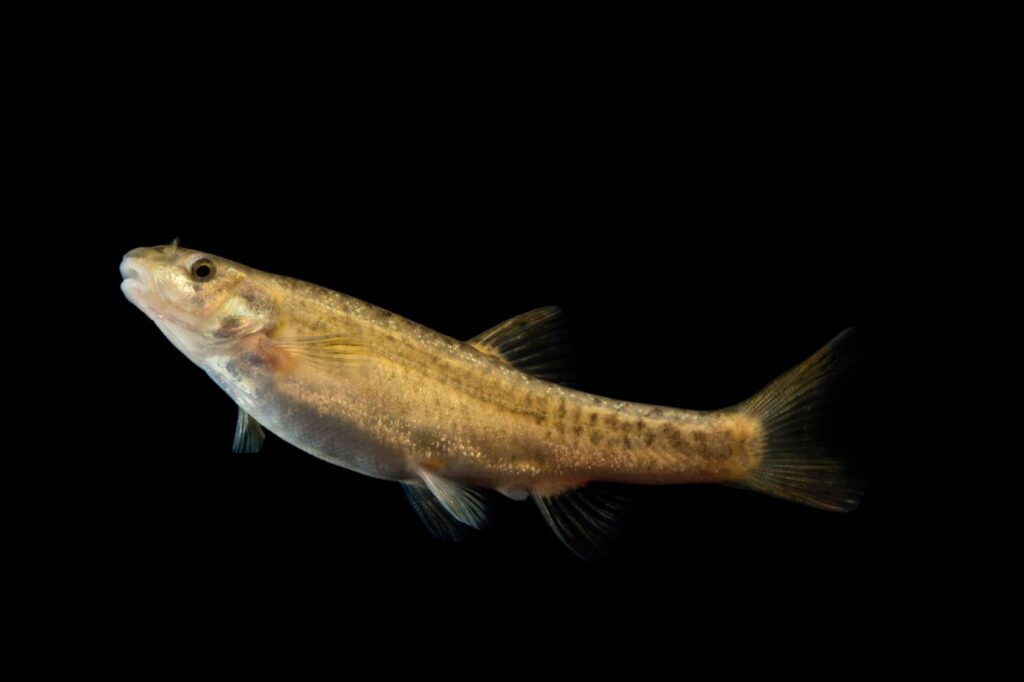
Speckled dace have a brownish or gray color and are a small minnow species that live in Yellowstone National Park.
©Usha Roy/Shutterstock.com
A small fish measuring around 4 to 5 inches, the speckled dace (Rhinichthys osculus) is a fish found in Yellowstone and other waters in North America. Clear and high-oxygenated waters are where this species lives, and they get their name from the mottled pattern that covers their body. Speckled dace have a brownish or gray color and are a small minnow species that live in Yellowstone National Park. Breeding for this small fish occurs in the spring in Yellowstone, and they can lay up to 200 to 500 eggs in total.
4. Longnose Dace

Longnose dace feed on small insects and algae in the water and are an important food source for larger fish in the water.
©Steve Byland/Shutterstock.com
Native to Yellowstone, the longnose dace (Rhinichthys cataractae) is a species named after its elongated snout. This fish is a small minnow species that grows to be around 2 to 4 inches large. Longnose dace have tan coloring and a sleek body. These fish feed on small insects and algae in the water and are an important food source for larger fish in the water.
In Yellowstone, the longnose dace are found in muddy and warm waters and can also live in murky waters. Having this fish in the water is considered an indication of a healthy ecosystem.
5. Yellowstone Cutthroat
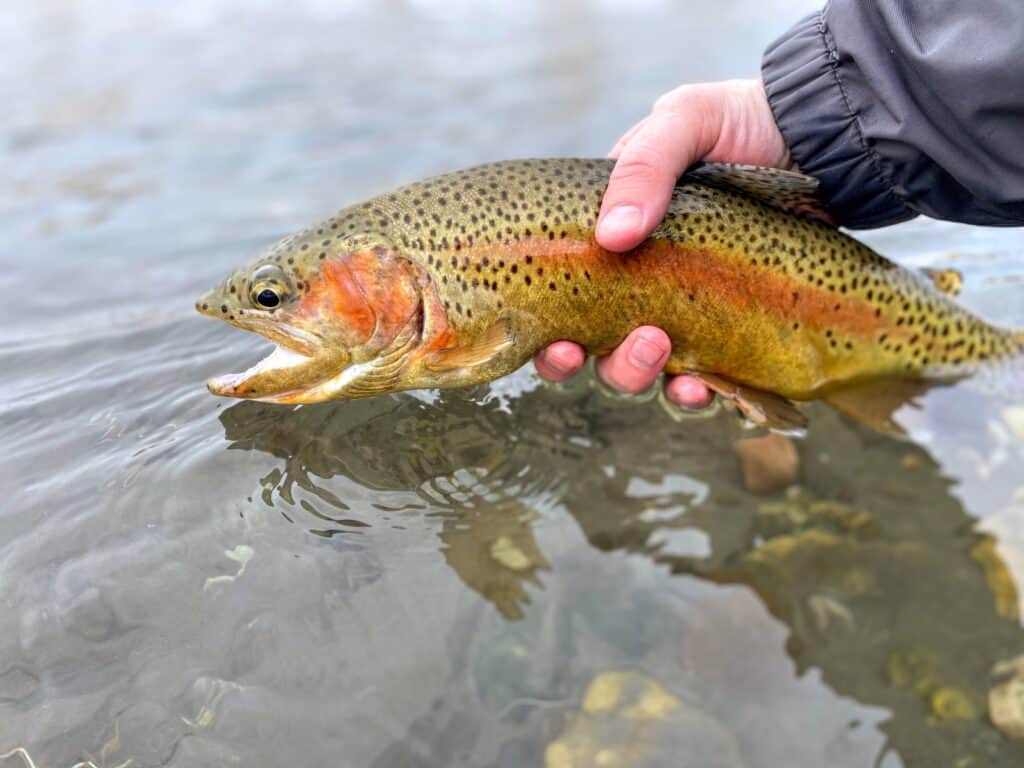
Cutthroat fish in Yellowstone get their name from the red coloring around their neck, which looks like their throat is bleeding.
©Ryan Cuddy/Shutterstock.com
A widespread species in the park, Yellowstone cutthroat (Oncorhynchus clarkii bouvieri) are a native species to Yellowstone national park. An important species, this fish is a reliable food source for animals like bears, otters, rivers, and about 16 species in total. Spawning for this fish occurs in the spring, and Yellowstone contains the largest inland population of this fish in the world.
This trout ranges from 6 to 20 inches long. Other invasive trout species compete with this fish for food and breeding rights. Cutthroat trout have been extirpated from some waters, but restoration efforts are being made so they can keep their home in the park.
The Snake river fine-spotted cutthroat trout (Oncorhynchus clarki behnkei) is another cutthroat species and gets its name since it inhabits the Snake River. The pattern on the snake river cutthroat distinguishes them from the Yellowstone cutthroat, but the two are genetically identical.
Another subspecies of cutthroat that lives in Yellowstone is the west slope cutthroat (Oncorhynchus clarkii lewisi). This fish lacks spots on the sides of its belly but has them on its back and tail.
Yellowstone cutthroats have a reddish hue on their throat, which gives them their name and helps distinguish them from the rainbow trout.
6. Redside Shiner
Lakes, ponds, and rivers are where the redside shiner (Richarsonius balteatus) lives. This species gets its name from the red marking on its side. They have grayish colorings, a thin striper, and yellowish bellies. Redside shiners grow to around 7 inches large, and this small fish is an important food source for other aquatic life like cutthroat trout.
Plankton and water insects are what the redside shiner primarily eats. They only live for around 5 years in the wild and breed in the late spring and summer months. Yellowstone lake and Snake River are where this small species may be found.
7. Sucker Fish
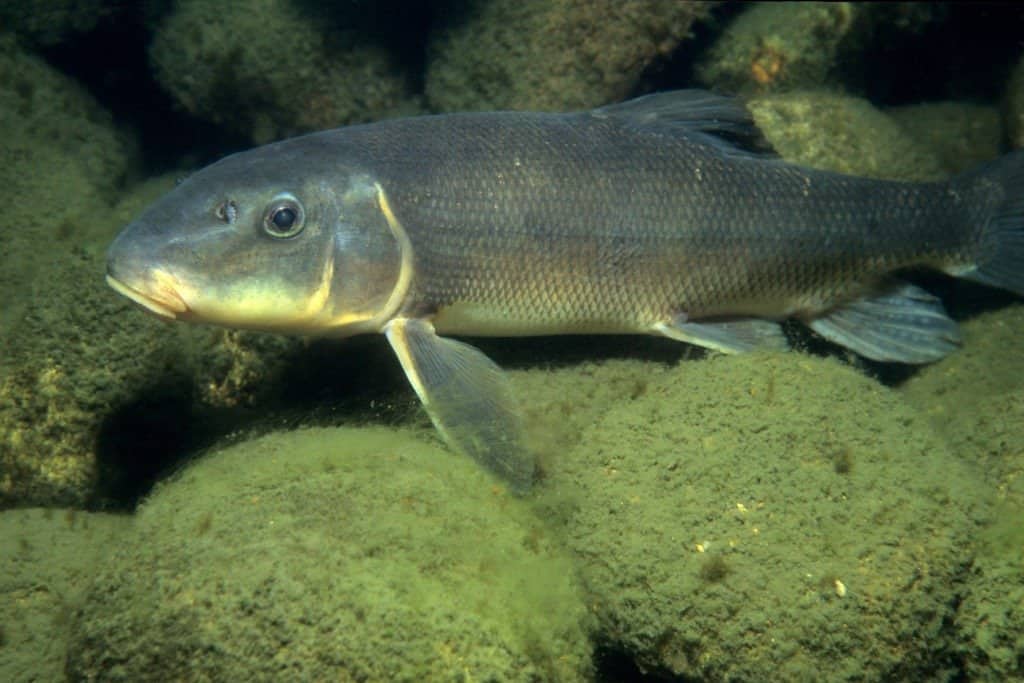
Suckers grow between 6 and 20 inches in length, and most do not get much heavier than 8 lbs.
©RLS Photo/Shutterstock.com
In the waters of Yellowstone live a variety of sucker fish that spend their time on the bottom of the river floor. There are 3 species of sucker fish that live in Yellowstone:
- Mountain Sucker (Catostomus platyrhynchus)
- Utah Sucker (Catostomus ardens)
- Longnose Sucker (Catostomus catostomus)
The suckers feed on algae, plankton, small insects, and crustaceans. They are also used as a food source for animals like birds, bears, and larger fish that feed on them. Suckers grow between 6 and 20 inches in length, and most do not get much heavier than 8 lbs.
The suckers that live in the park are found in water sources like Yellowstone Lake, and their population has recently declined. Larger fish feeding on their eggs and young are what cause their numbers to decline.
8. Lake chub
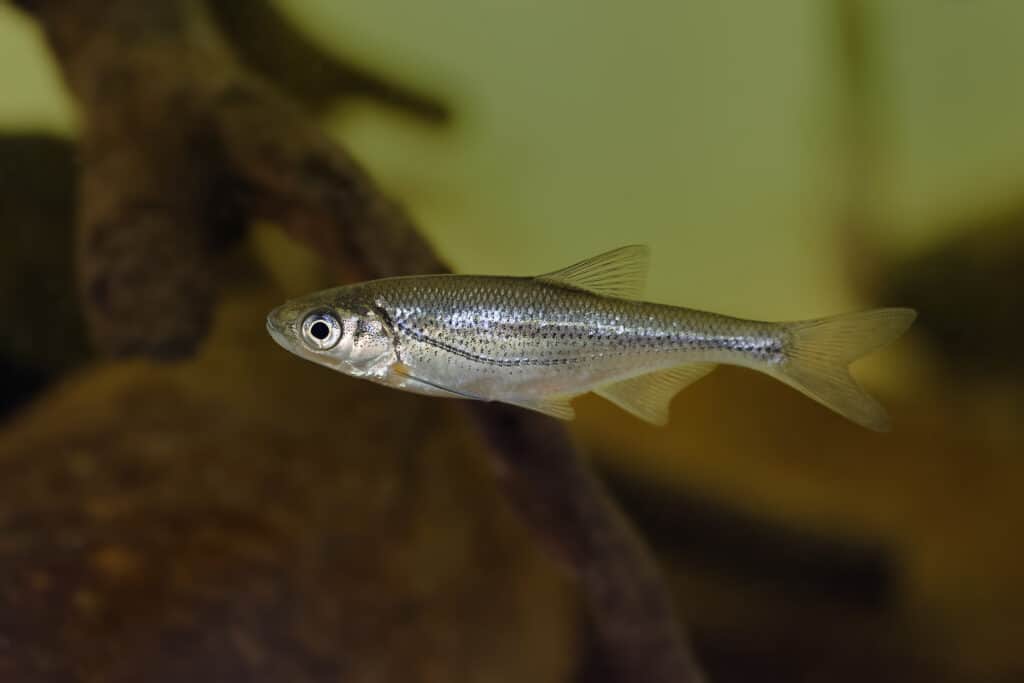
Chubs are a common fish to use as bait for fishing due to their size and glistening scales that attract fish that eat this species.
©iStock.com/phototrip
The lake chub (Couesius plumbeus) is not native to Yellowstone National Park but can be found in the park waters like Yellowstone Lake. This species is originally found in Montana and the drainages of Yellowstone River. Lake chubs are small with a blueish-gray coloring, growing to be around 6 inches large when mature. Their small size makes them food for larger fish that inhabit the same waters. The lake chub is more active during spring when they breed.
This fish prefers cold, clean water. They are a common fish to use as bait for fishing due to their size and glistening scales that attract fish that eat this species.
9. Mottled Sculpin
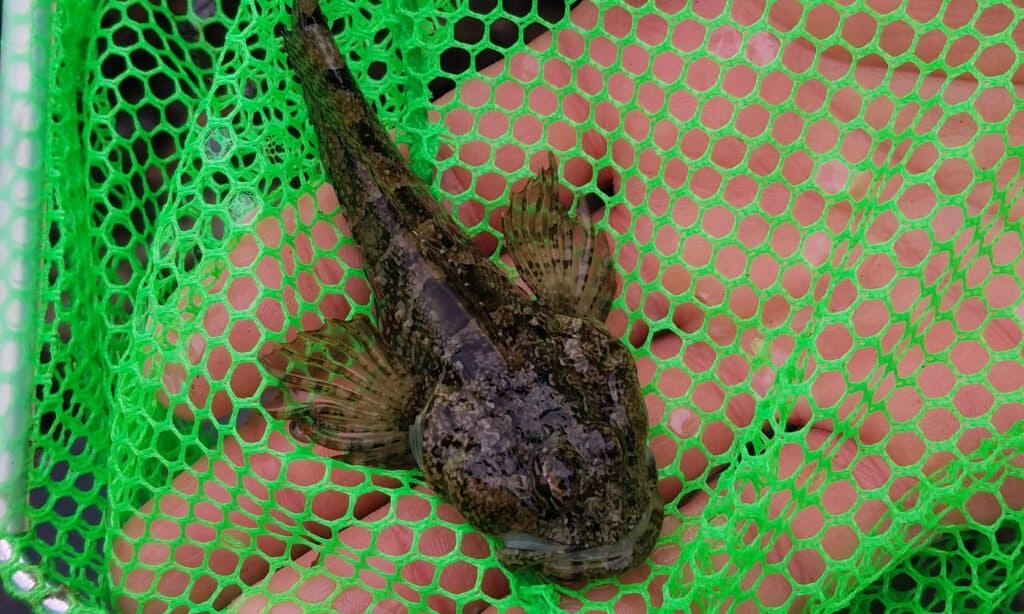
Sculpin fish has tan coloring and is covered with a mottled pattern.
©JortPics/Shutterstock.com
A freshwater fish found across North America, the mottled sculpin (Cottus bairdii) is a species that also inhabits Yellowstone park. Mottled sculpin prefers clear and fresh water with high levels of oxygen. They primarily live in mountainous regions and rocky waterways.
Mottled sculpins are a small species that only gets to around 5 inches and only lives for around 3 years. This fish has tan coloring and is covered with a mottled pattern. Fish eggs, small insects, and crustaceans are what this fish eats.
10. lake trout

Most lake trout live around 25 years, but the oldest grew to be 70 years old.
©VvoeVale/Shutterstock.com
1994 is when the Lake trout (Salvelinus namaycush) was first documented in Yellowstone. This fish is native to Canada, Alaska, and the Great Lakes. Lake Trout is a large species that has grown up to 50 lbs in Wyoming but is around 15 to 40 lbs on average. This species grows between 24 to 36 inches and can compete with native fish like cutthroat by eating all their food and young.
Lake trout live in deeper waters and come to the surface less often, so it is harder for animals like birds and bears to feed on them. Lake trout are also heavy breeders; one female can lay between 400 and 1,200 eggs. Sexually maturity is reached at 6 or 7 years old, and this fish lives for around 25 years.
11. Brown Trout
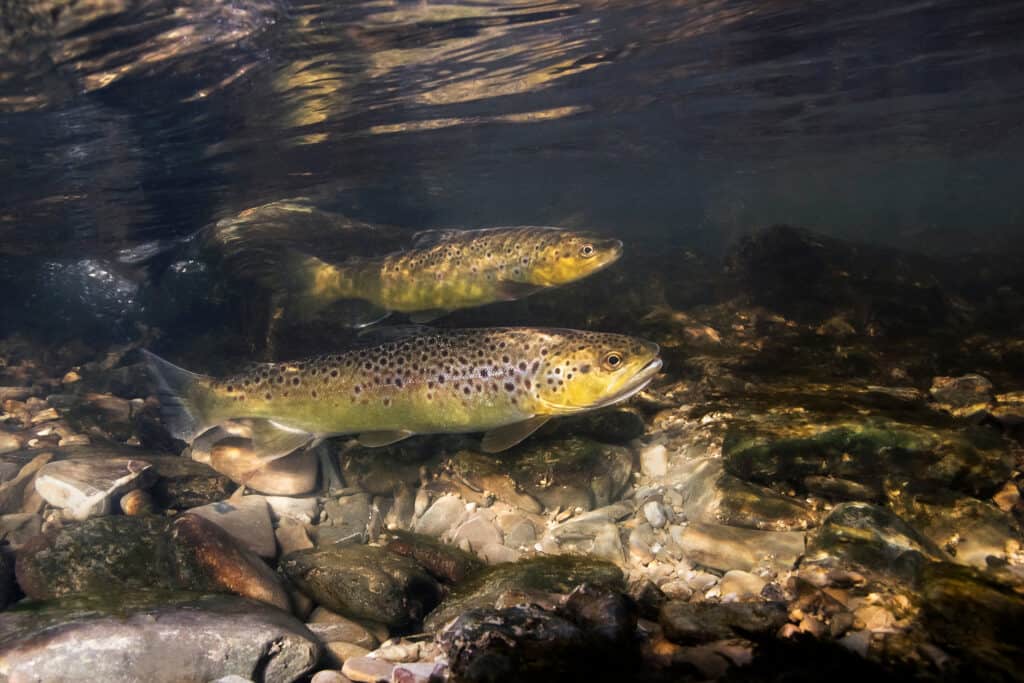
Brown trouts have a forked tail with a small fin and a yellow-colored abdomen.
©Rostislav Stefanek/Shutterstock.com
Brown trout (Salmo trutta) are an invasive species to Yellowstone and are one of the reasons native species have become less common in the area. Originally native to Europe, the brown trout range between 7 to 14 inches, with the largest growing up to 20 inches long. The largest of these species can grow up to 20 lbs.
Brown trout have tan coloring and are covered in a speckled pattern. They have a forked tail with a small fin and a yellow-colored abdomen.
12. Rainbow Trout
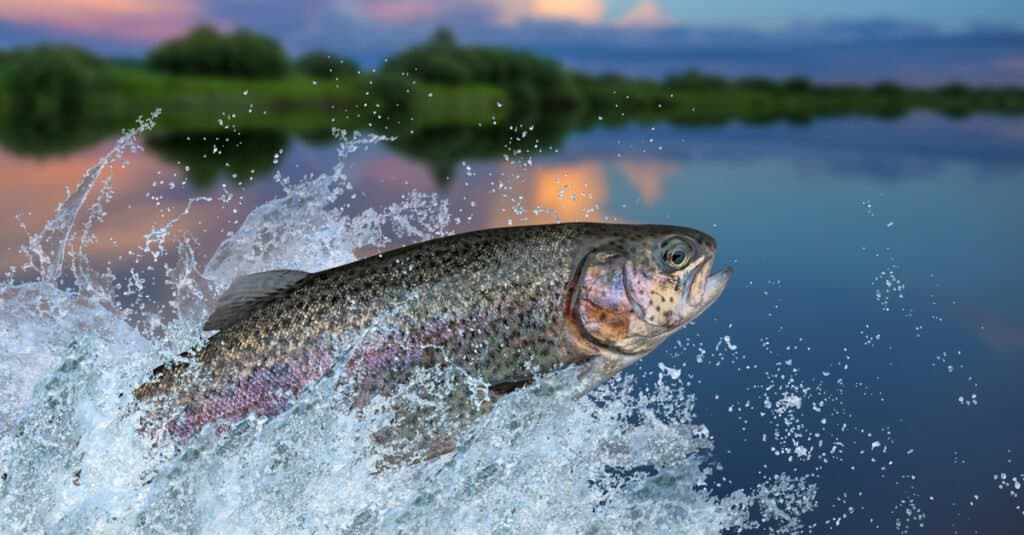
It is common for rainbow trout and other fish to jump out of the water to catch insects and other prey.
©FedBul/Shutterstock.com
While native to North America, the rainbow trout (Oncorhynchus mykiss) is a species that is not native to Yellowstone. This fish lives in fast-moving streams and rivers within the park, living in similar areas as other cutthroat trout. While rainbow trout naturally compete with other similar fish species, they have also been shown to breed with cutthroat and create hybrids.
Fully mature rainbow trout can grow to 20 to 30 inches and weigh between 2 to 16 lbs. This fish can become larger; the largest ever recorded weighed 48 lbs. The taste of this fish is also delicious and is a choice pick for fishermen looking to get a good meal.
Up Next:
The 7 Best Hikes in Yellowstone National Park
Discover the Largest Snake Found in Yellowstone National Park
Angling in Yellowstone: 6 Best Spots & Fish to Catch
The 9 Best Lakes in the United States for Fishing
The photo featured at the top of this post is © iStock.com/T Schofield
Thank you for reading! Have some feedback for us? Contact the AZ Animals editorial team.






